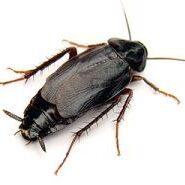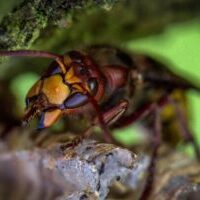
BOXEDLER BUGS
Boxelder bug eggs are a light yellow and turn reddish as the development is almost complete. First instar nymphs are approximately 1.3 mm in length, with black wing pads and have bright red abdomens. The legs and antennae are black. The nymphs become darker red as they mature through the five nymphal instars. The brownish-black adults are about 12 mm long and somewhat flattened on the top. Three prominent longitudinal stripes on the thorax and the margins of the basal half of the wings are reddish orange. The adult’s abdomen is also reddish orange.
With the approach of fall, this species congregates in large numbers on the south side of trees, buildings, and rocks exposed to the sun. It is during this period that homeowners become aware of the insects. In late April to early May, the bugs emerge from hibernation about the time buds on boxelder trees begin opening. They fly back to host trees where they remain active over the growing season. Nymph boxelder bugs feed on foliage and seeds by inserting their piercing-sucking mouthparts into these tissues. They continue feeding until they mature into adults. Depending on weather conditions, one to two generations may be produced each year.
Both nymphs and adults remove plant fluid from newly developing leaves that may result in distortion of the foliage. In addition to foliar feeding, boxelder bugs may also damage flowers, tender twigs, and seeds of boxelder. It is, however, because of the boxelder bugs propensity to enter homes that causes the most alarm. Although the insects cause no direct damage to the structure, contents or the occupants, their presence is a nuisance. In heavily infested areas, thousands of boxelder bugs may enter the living quarters of buildings.
Exclusion is the best method to keep boxelder bugs from entering homes and buildings. Cracks around windows, doors, siding, utility pipes, chimneys, and other openings should be sealed with a silicone caulk or expanding foam product. Exterior applications of insecticides may offer some relief from infestations where the task of completely sealing the exterior is difficult or impossible. Applications should consist of a synthetic pyrethroid (i.e. deltamethrin, cyfluthrin, lambda-cyhalothrin, cypermethrin, or sumithrin) and should be applied by a licensed pest control professional in the fall just prior to bug congregation.
EXPERTS IN PEST CONTROL SINCE 1970!
Enter your information or call
(816) 279-2000
By clicking “GET ESTIMATE” I authorize Preferred Pest Control to contact me at this number. I understand I am not required to make a purchase.
PREFERRED PEST CONTROL
At Preferred Pest Control & Home Inspections, we offer comprehensive indoor and outdoor pest extermination and treatment services to stop infestations at their source. Our qualified exterminators are equipped to inspect your home environment, identify the scope of the problem, and determine the best course of action to eliminate those unwanted pests.
And when you hire us, you’ll benefit from our:
-
Reasonable pest extermination rates.
-
Easy, convenient appointment scheduling.
-
Dedication to your safety and comfort.
If you think you might have a pest problem, don’t wait to get help. Call today for more information or to request an estimate.
As the leading pest extermination provider in NW Missouri and NE Kansas, we're equipped to handle any pest that may pop up and protect your property from future problems.
AREAS WE SERVICE












